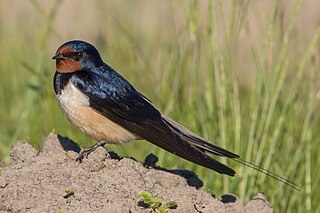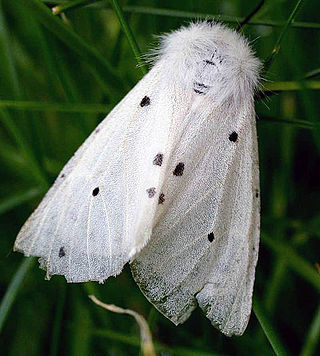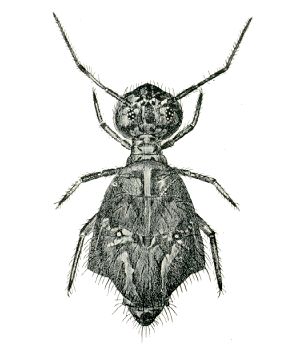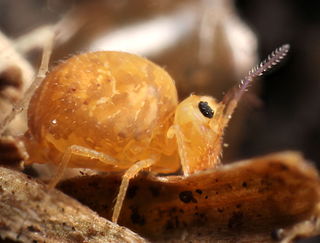
The barn swallow is the most widespread species of swallow in the world, occurring on all continents, with vagrants reported even in Antarctica. It is a distinctive passerine bird with blue upperparts and a long, deeply forked tail. In Anglophone Europe, it is just called the swallow; in northern Europe, it is the only member of family Hirundinidae called a "swallow" rather than a "martin".

The swallows, martins, and saw-wings, or Hirundinidae are a family of passerine songbirds found around the world on all continents, including occasionally in Antarctica. Highly adapted to aerial feeding, they have a distinctive appearance. The term "swallow" is used as the common name for Hirundo rustica in the UK and Ireland. Around 90 species of Hirundinidae are known, divided into 21 genera, with the greatest diversity found in Africa, which is also thought to be where they evolved as hole-nesters. They also occur on a number of oceanic islands. A number of European and North American species are long-distance migrants; by contrast, the West and South African swallows are nonmigratory.

The rustic bunting is a passerine bird in the bunting family Emberizidae, a group now separated by most modern authors from the finches, Fringillidae. The genus name Emberiza is from Old German Embritz, a bunting. The specific rustica is Latin for "rustic, simple".

The bird genus Hirundo is a group of passerines in the family Hirundinidae. The genus name is Latin for a swallow. These are the typical swallows, including the widespread barn swallow. Many of this group have blue backs, red on the face and sometimes the rump or nape, and whitish or rufous underparts. With fifteen species this genus is the largest in its family.

Roman agriculture describes the farming practices of ancient Rome, during a period of over 1000 years. From humble beginnings, the Roman Republic and the Roman Empire expanded to rule much of Europe, northern Africa, and the Middle East and thus comprised many agricultural environments of which the Mediterranean climate of dry, hot summers and cool, rainy winter was the most common. Within the Mediterranean area, a triad of crops were most important: grains, olives, and grapes.

Nicotiana rustica, commonly known as Aztec tobacco or strong tobacco, is a rainforest plant in the family Solanaceae native to South America. It is a very potent variety of tobacco, containing up to nine times more nicotine than common species of Nicotiana such as Nicotiana tabacum. More specifically, N. rustica leaves have a nicotine content as high as 9%, whereas N. tabacum leaves contain about 1 to 3%. The high concentration of nicotine in its leaves makes it useful for producing pesticides, and it has a wide variety of uses specific to cultures around the world. However, N. rustica is no longer cultivated in North America, as N. tabacum has replaced it.
An ergastulum was a Roman workhouse building used as a type of factory with slaves held in chains or to punish slaves. The ergastulum was usually built as a deep, roofed pit below ground level, large enough to allow the slaves to work within it, and containing narrow spaces in which they slept. Ergastula were common structures on all slave-using farms (latifundia). The etymology is disputed between two possible Greek roots: ergasterios "workshop" and ergastylos "pillar to which slaves are tethered."

The African fish eagle or the African sea eagle is a large species of eagle found throughout sub-Saharan Africa wherever large bodies of open water with an abundant food supply occur. It is the national bird of Malawi, Namibia, Zambia, and Zimbabwe. As a result of its large range, it is known in many languages. Examples of names include: Vis Arend in Afrikaans, nkwazi in Chewa, aigle pêcheur in French, hungwe in Shona, inkwazi in isiZulu, and ntšhu in Northern Sotho. This species may resemble the bald eagle in appearance; though related, the two species occur on different continents, with the bald eagle being resident in North America.

Manduca rustica, the rustic sphinx, is a moth of the family Sphingidae. The species was first described by Johan Christian Fabricius in 1775.

The slaty finch is a bird species in the family Thraupidae.

Villa rustica was the term used by the ancient Romans to denote a farmhouse or villa set in the countryside and with an agricultural section, which applies to the vast majority of Roman villas. In some cases they were at the centre of a large agricultural estate, sometimes called a latifundium. The adjective rustica was used only to distinguish it from a much rarer sub-urban resort villa, or otium villa built for purely leisure and luxury, and typically located in the Bay of Naples. The villa rustica would thus serve both as a residence of the landowner and his family and also as a farm management centre. It would often comprise separate buildings to accommodate farm labourers and sheds and barns for animals and crops.

Diaphora mendica, the muslin moth, is a moth of the family Erebidae. It is found in the Palearctic realm east to Lake Baikal.

Sminthuridae, not to be confounded with: Sminthurididae, is a family of springtails of the order Symphypleona. Sminthurids are commonly referred to as globular springtails.

Patella rustica, the Lusitanian limpet or rustic limpet is a species of sea snail, a true limpet, a marine gastropod mollusk in the family Patellidae, one of the families of true limpets. It is a rocky shore intertidal mollusc found throughout the Mediterranean and the north-east Atlantic from Mauritania to southern France.

Columbella rustica is a species of sea snail, a marine gastropod mollusk in the family Columbellidae, the dove snails.
Bourletiella viridescens is a species of springtail. Its common name is "Garden Springtail"

Bourletiella hortensis is a springtail of the family Bourletiellidae. The species common name is garden springtail. It feeds on moss and fungi.

Bourletiellidae is a family of springtails in the order Symphypleona.
Bourletiella juanitae is a species of globular springtails, arthropods in the family Bourletiellidae.

Bourletiella arvalis is a species of globular springtails in the family Bourletiellidae.
















